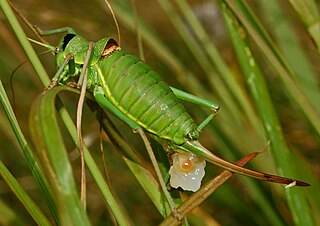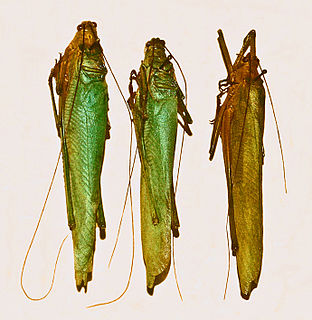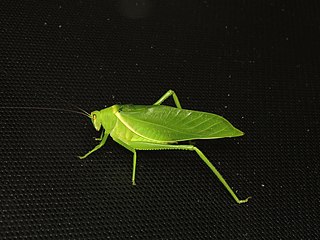
The Phaneropterinae, the sickle-bearing bush crickets or leaf katydids, are a subfamily of insects within the family Tettigoniidae. Nearly 2,060 species in 85 genera throughout the world are known. They are also known as false katydids or round-headed katydids.

Scudderia is a genus of katydids in the subfamily Phaneropterinae. Their range is most of North America, northernmost being in Southern Canada. They are herbivores, with nymphs feeding primarily on flowers and adults preferring woody deciduous plants.

The Bradyporinae are a subfamily in the family Tettigoniidae, based on the type genus Bradyporus. First described as a family, "Bradyporidae", the first use as Bradyporinae was by Brunner von Wattenwyl in 1878.

Holochlora is a genus of bush-crickets in the subfamily Phaneropterinae. They occur in Africa and Asia.

Zeuneria melanopeza is a species of katydids crickets in family Tettigoniidae subfamily Phaneropterinae.

The Hetrodinae are a subfamily of robust orthopterans in the family Tettigoniidae.

Barbitistes constrictus is a species belonging to the family Tettigoniidae subfamily Phaneropterinae. It is found in Austria, Belarus, Central European Russia, Czech Republic, Estonia, Germany, Hungary, Kaliningrad Region, Latvia, Lithuania, North European Russia, Northwest European Russia, Poland, Romania and Slovakia. The species is found mainly in coniferous forests.

Isophya kraussii is a species belonging to the family Tettigoniidae subfamily Phaneropterinae. It is found in Poland, Germany, Austria, the Czech Republic, Slovakia, Slovenia, Croatia and Hungary. The species prefers bushy dry grasslands, forest edges and high-growing, slightly wet meadows. The imagines appear early in the year from about mid-June, but the majority are to be found from July.

Paracaedicia is a genus of bush cricket in the subfamily Phaneropterinae. Species can be found mostly in New Guinea.

Sanaa regalis is a species of insect in the bush-cricket or katydid family, Tettigoniidae, found in the Himalayas. It was first described in 1895 by Carl Brunner von Wattenwyl, as Termera regalis.

Ducetia is the type genus of the Ducetiini: a tribe of Asian bush crickets.
Zulpha is a monotypic genus of bush crickets containing only the species Zulpha perlaria.
Isopsera is an Asian genus of bush crickets in the subfamily Phaneropterinae. Species can be found in India, Indochina, Malesia and the Pacific Islands.
Hemielimaea is a genus of Asian bush crickets found in Indochina and China.
Ectadia is a genus of Asian bush crickets of the tribe Elimaeini.
Psyrana is a genus of Asian bush crickets of the tribe Holochlorini within the subfamily Phaneropterinae. They occur in Sri Lanka Indo-China, China, Korea, Japan, and Malesia to New Caledonia.

Orophus tessellatus, the false leaf katydid, is a species of katydid native to Mexico, Central America, and South America. It is in the large subfamily Phaneropterinae within the tribe Amblycoryphini. Its coloring varies from brown to green, some with spots, mottling, or uniform in coloration. The body length reaches 16 mm (0.63 in) in males and 22 mm (0.87 in) in females. The ovipositor is approximate 7 mm (0.28 in) in length. The species is characterized by the size of the forewings and their "dirty" coloring.
Hyperbaenus is a genus of South American Orthopterans, sometimes known as 'leaf-folding crickets' in the family Gryllacridinae. It is the type genus for its tribe Hyperbaenini and the new subfamily Hyperbaeninae.

Poecilimon is a genus of bush crickets in the subfamily Phaneropterinae and tribe Barbitistini. Species can be found in: central and Southeast Europe, the south of the European part of the former USSR, Asia Minor, Syria, Palestine, the Caucasus, Persia and extends in Central Asia to the Altai mountains.
Neanias is a genus of Orthopterans, sometimes known as 'leaf-folding crickets' in the subfamily Gryllacridinae and tribe Gryllacridini. The recorded distribution is: Indian subcontinent, Japan, Hainan, Indochina, and western Malesia (Sumatra).















